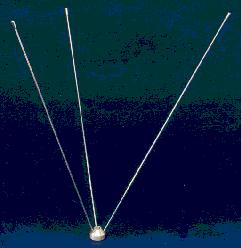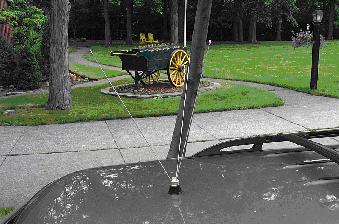The Nil-Jon
HD-V/U-Super-M Mobile Antenna
An Amateur Radio Antenna
Review
By
Christopher Eppich (W8CWE)
Introduction
I had recently discovered a great new line of antennas manufactured by the Nil-Jon Antenna company here in the Cleveland area. Being always the inquisitive type when it comes to unique antenna designs, I was immediately intrigued by their latest mobile antenna offering. This article documents the various paces I put the Super-M through this past Summer. As you will come to know as you progress through this article, I found the Super-M to be one of the most versatile mobile antenna designs I’ve ever used.
A Unique Design
The patent pending HD-V/U Super-M mobile antenna is a strange creature to
behold at first glance. The main body of the actual assembly consists of a
finely machined aircraft aluminum base from which three radials of differing
lengths protrude at angles. The Super-M is a strange sight to anyone who is
used to mobile antennas consisting of a single vertical whip. My first
impression was of a “mini Sputnik” mounted to the top of my vehicle. Any
reservations I might have had prior to using the Super-M soon disappeared as
the QSOs began to pile up.
So How Does it Work?
Configuring three different radial lengths at angles to one another results
in an interesting radiation pattern which, consequently is the ultimate reason
for this unit’s fabulous performance. The engineered interaction between the
three elements results in a broad-banded pattern which favors a major lobe
toward the horizon, as well as a significant minor lobe above the horizon. To
the purist, this may seem less than ideal. However, this dual-lobe pattern
actually greatly increases the efficiency of the antenna by significantly
decreasing the nulls often seen with single lobe pattern collinear designs. In
effect, this low profile design actually helps get your signal out of the
valley via the upper lobe. Traditional collinear designs tend to shoot the
signal into the wall of the valley by nature of their single, highly compressed
lobe looking only toward the horizon.
Another significant advantage of the unique radial configuration is, in effect, a circular polarization effect which drastically reduces the “picket fencing” seen when signals reach the antenna via multipath. We all know that signal reflection and refraction all contribute to this undesirable effect by causing the received signal to reach the antenna at slightly different times, and/or with differing polarizations (vertical/horizontal flip-flop). The three radial design significantly reduces the “picket fencing” by supporting both types of polarization and thus removing one of the two major causes of this effect. The result is a significant stabilization of received signals, especially in areas where picket fencing is traditionally most apparent.
Why I Changed Mobile Antennas in the First Place
 My Super-M was obtained for use as a
VHF/UHF dual-band mobile antenna. I had previously been using the Diamond
SG7900A collinear which I found to be an excellent choice in and of itself. So
you are going to ask me why I was even considering a different antenna if the
Diamond worked so well, right? Well, that’s a fair question which deserves to
be addressed. The driving reason for the change is that I had just built a new
garage and now had a place to park my vehicles. Although the Diamond has the
nifty fold-over feature, it still was a significant effort to have to exit the
vehicle prior to pulling into the garage, as well as having to exit after
pulling out in the morning to place the antenna back into the upright position.
The low-profile design of the Super-M allowed me to leave the antenna
permanently mounted to the top of my vehicle. Traversing large commercial
parking garages without extra steps was also a factor in my decision.
My Super-M was obtained for use as a
VHF/UHF dual-band mobile antenna. I had previously been using the Diamond
SG7900A collinear which I found to be an excellent choice in and of itself. So
you are going to ask me why I was even considering a different antenna if the
Diamond worked so well, right? Well, that’s a fair question which deserves to
be addressed. The driving reason for the change is that I had just built a new
garage and now had a place to park my vehicles. Although the Diamond has the
nifty fold-over feature, it still was a significant effort to have to exit the
vehicle prior to pulling into the garage, as well as having to exit after
pulling out in the morning to place the antenna back into the upright position.
The low-profile design of the Super-M allowed me to leave the antenna
permanently mounted to the top of my vehicle. Traversing large commercial
parking garages without extra steps was also a factor in my decision.
Exercising the HD-V/U Super-M Mobile Antenna – Terrestrial Simplex Results
My first mobile 2M QSO using the Super-M was during a drive down one of the more hilly S.R.s near my home. The 20 minute drive is one I make three to five times per week and takes me approximately 10 miles north of two fixed stations I converse with daily. Having obviously had numerous similar QSOs with these stations using the Diamond, I was very impressed with the stability of the received signals using my new Nil-Jon Super-M. The telling moment was when I was going through a particularly bad track (a very steep and low valley) where I previously always got fading and flutter. Although there was some signal fade, the amount of flutter was significantly less than I had previously experienced. Reports on my transmitted signal were equally impressive. Neither fixed station was aware that I was even using a different antenna until I told them some days later.
I was unable to do any serious 70cm. simplex work during this trial. Most of the 70cm. activity in my area is on repeaters. There were a couple of minor contacts made, but these were with operators in my neighborhood and didn’t represent anything out of the ordinary. I should point out that using the Super-M for these contacts did not result in any degradation of received signal from what I was used to using the Diamond.
Terrestrial Repeater Results
In a word, Wow! The significantly low-profile antenna really shines for repeater work. Everything programmed into my Yaesu FT 8100 could be worked using the Super-M. Of particular note were a couple of 70 cm. repeaters that normally were noisy in certain areas using the Diamond. These repeaters were significantly more quiet on the Super-M when worked in these same areas that are traditionally noisy with the Diamond. I will say that for overall brute gain on 2 meters, the Diamond was better in most “line of sight” situations. The telling tale for me is the overall average performance (taking many different operating conditions into consideration such as; line of sight, out of the valley, in the city with tall buildings, etc) when comparing the Super-M with Diamond. For as many different conditions as I was in using both of these antennas, the Super-M actually comes out with slightly higher marks overall.
Mobile Satellite Work
 This was the most educational test I
did. In fact, it was through this test that I became aware of the secondary
transmission lobe which distinguishes the Super-M from other mobile designs. I
was able to copy the AO27 satellite coming over the horizon, and could hold the
signal until just before apogee. The high gain collinear Diamond worked well at
the horizon, but the capture time was limited as the antenna’s major signal
lobe was toward the horizon only. The dual polarization of the Super-M also had
a huge impact on receiving the satellite’s circularly polarized downlink
signal. If for no other reason, if you are a mobile satellite junkie, you will
be pleasantly surprised at how well the Super-M performs for this type of
amateur work.
This was the most educational test I
did. In fact, it was through this test that I became aware of the secondary
transmission lobe which distinguishes the Super-M from other mobile designs. I
was able to copy the AO27 satellite coming over the horizon, and could hold the
signal until just before apogee. The high gain collinear Diamond worked well at
the horizon, but the capture time was limited as the antenna’s major signal
lobe was toward the horizon only. The dual polarization of the Super-M also had
a huge impact on receiving the satellite’s circularly polarized downlink
signal. If for no other reason, if you are a mobile satellite junkie, you will
be pleasantly surprised at how well the Super-M performs for this type of
amateur work.
The Super-M as a Base Antenna
After seeing how well the Super-M performed for satellite work in a mobile environment, I was anxious to see if I could get similar results using it as a base antenna. I was able to fashion a crude ground plane using an old steel circular saw blade and some stock aluminum tubing. The resulting ground plane worked out well as I was able to simply interface the Super-M via my mobile magnet mount. As with the mobile performance, the Super-M did quite well configured as a base antenna. Satellite reception was similar to what I expected, albeit somewhat less than ideal. Let’s face it, there are much better choices when it comes to base satellite antennas. The main thing that impressed me was that it DID in fact work!
The single most impressive result came one evening when I was able to hold a 70 cm. QSO with one of our regular 2M operators who is approximately 30 miles away from my QTH. Although he was using a high gain yagi, I was reduced to a 5W HT interfaced to my makeshift Super-M base antenna assembly. Holding this one QSO was most impressive to me.
The Super-M as a Scanner Antenna
The Super-M can also be employed as a dedicated mobile scanner antenna with equally fabulous results. Although I didn’t spend much time putting it through it’s paces in this fashion, I can honestly say that it performed quite well for me between 140 MHz to well into the 800 MHz band. Nil-Jon claims coverage from 25-1300 MHz. Again, it’s low profile design makes the Super-M an exceptional choice for mobile scanner enthusiasts. A recent review done by Bob Grove appeared in the June, 2000 edition of Monitoring Times giving the Super-M rave reviews.
Concluding Thoughts
The Nil-Jon HD-V/U-Super-M mobile antenna delivers as promised. Don’t be
fooled by it’s small, low-profile design as it showed me that it is able to
equal, or even outperform antennas twice it’s size. If you are in the market
for a single antenna that can perform multiple tasks, this is really worth a
try.
Super-M Specifications:
Transmit Frequency Range: 140 thru 170 MHz*
200 thru 225 MHz
400 thru 480 MHz*
Receive Frequency Range: 25-1300 MHz (140 thru 860 MHz*)
*Tested and Confirmed by the Author
Height: 18-inches (without mount)
Tuning Requirements: None
Polarization: Dual (Both Vertical & Horizontal Polarization)